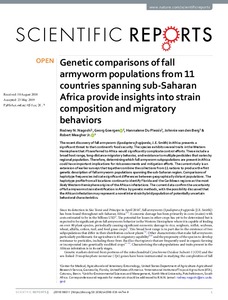| dc.contributor.author | Nagoshi, R.N. |
| dc.contributor.author | Goergen, G. |
| dc.contributor.author | Plessis, H. du |
| dc.contributor.author | Van den Berg, J. |
| dc.contributor.author | Meaghe, R. |
| dc.date.accessioned | 2019-12-04T11:33:59Z |
| dc.date.available | 2019-12-04T11:33:59Z |
| dc.date.issued | 2019-06-05 |
| dc.identifier.citation | Nagoshi, R.N., Goergen, G., du Plessis, H., van den Berg, J. & Meagher, R. (2019). Genetic comparisons of fall armyworm populations from 11 countries spanning sub-Saharan Africa provide insights into strain composition and migratory behaviors. Scientific Reports, 9(1): 8311, 1-11. |
| dc.identifier.issn | 2045-2322 |
| dc.identifier.uri | https://hdl.handle.net/20.500.12478/5860 |
| dc.description | Open Access Journal; Published online: 05 June 2019 |
| dc.description.abstract | The recent discovery of fall armyworm (Spodoptera frugiperda, J.E. Smith) in Africa presents a significant threat to that continent’s food security. The species exhibits several traits in the Western Hemisphere that if transferred to Africa would significantly complicate control efforts. These include a broad host range, long-distance migratory behavior, and resistance to multiple pesticides that varies by regional population. Therefore, determining which fall armyworm subpopulations are present in Africa could have important implications for risk assessments and mitigation efforts. The current study is an extension of earlier surveys that together combine the collections from 11 nations to produce the first genetic description of fall armyworm populations spanning the sub-Saharan region. Comparisons of haplotype frequencies indicate significant differences between geographically distant populations. The haplotype profile from all locations continue to identify Florida and the Caribbean regions as the most likely Western Hemisphere origins of the African infestations. The current data confirm the uncertainty of fall armyworm strain identification in Africa by genetic methods, with the possibility discussed that the African infestation may represent a novel interstrain hybrid population of potentially uncertain behavioral characteristics. |
| dc.description.sponsorship | United States Agency for International Development |
| dc.format.extent | 1-11 |
| dc.language.iso | en |
| dc.rights | CC-BY-4.0 |
| dc.subject | Spodoptera Frugiperda |
| dc.subject | Food Security |
| dc.subject | Africa |
| dc.subject | Risk Assessment |
| dc.subject | Genetics |
| dc.title | Genetic comparisons of fall armyworm populations from 11 countries spanning sub-Saharan Africa provide insights into strain composition and migratory behaviors |
| dc.type | Journal Article |
| dc.description.version | Peer Review |
| cg.contributor.affiliation | United States Department of Agriculture |
| cg.contributor.affiliation | International Institute of Tropical Agriculture |
| cg.contributor.affiliation | North-West University |
| cg.coverage.region | Africa |
| cg.coverage.region | Central Africa |
| cg.coverage.region | East Africa |
| cg.coverage.region | Southern Africa |
| cg.coverage.region | West Africa |
| cg.coverage.country | Central African Republic |
| cg.coverage.country | Congo, Dr |
| cg.coverage.country | Ghana |
| cg.coverage.country | South Africa |
| cg.coverage.country | Togo |
| cg.coverage.country | Zambia |
| cg.creator.identifier | Georg Goergen: 0000-0003-4496-0495 |
| cg.researchtheme | PLANT PRODUCTION & HEALTH |
| cg.isijournal | ISI Journal |
| cg.authorship.types | CGIAR and developing country institute |
| cg.iitasubject | Pests Of Plants |
| cg.iitasubject | Plant Genetic Resources |
| cg.iitasubject | Plant Health |
| cg.journal | Scientific Reports |
| cg.howpublished | Formally Published |
| cg.accessibilitystatus | Open Access |
| local.dspaceid | 105625 |
| cg.targetaudience | Scientists |
| cg.identifier.doi | https://dx.doi.org/10.1038/s41598-019-44744-9 |

